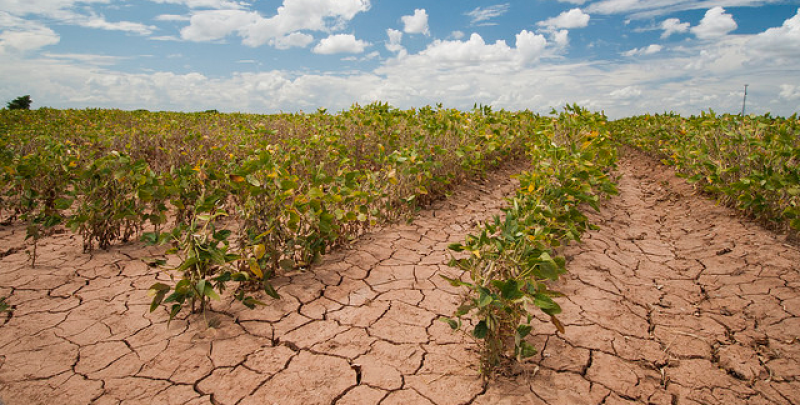agri-geomatics-agrog@agr.gc.ca
Type of resources
Available actions
Topics
Keywords
Contact for the resource
Provided by
Formats
Representation types
Update frequencies
status
-

Difference from normal soil moisture is the modelled amount of plant available water (mm) in the root zone of the soil, minus the average amount that has historically been available on that day. This value is intended to provide users with a representation of conditions above or below normal and by the amount of water (mm). Values are computed using the Versatile Soil Moisture Budget (VSMB)
-

The Crop Stress Index is the ratio of actual evapotranspiration (AET) to potential evapotranspiration (PET) express as: CSI = 1-(AET/PET) AET and PET are calculated within the Versatile Soil Moisture Budget (VSMB) model using temperature and precipitation data and a crop-specific biometeorological time scale model to estimate growth stage (Robertson, 1968), with crop specific phenological and crop water extraction coefficients taken from Chipanshi et al 2013. The WDI ranges between 0 and 1, with a value closer to 1 indicating higher stress Crop Stress Index is modelled for each climate station using measured precipitation and temperature
-

The ‘Circa 1995 Landcover of the Prairies’dataset is a geospatial raster data layer portraying the rudimentaryland cover types of all grain-growing areas of Manitoba, Saskatchewan, Alberta and northeastern British Columbia at a 30-metre resolution for the 1995 timeframe. It is the collection of all the classified imagery (1993 to 1995) of the Western Grain Transition Payment Program (WGTPP) assembled into a single seamless raster data layer.
-

Each pixel value corresponds to the actual number (count) of valid Best-quality Max-NDVI values used to calculate the mean weekly values for that pixel. Since 2020, the maximum number of possible observations used to create the Mean Best-Quality Max-NDVI for the 2000-2014 period is n=20. However, because data quality varies both temporally and geographically (e.g. cloud cover and snow cover in spring; cloud near large water bodies all year), the actual number (count) of observations used to create baselines can vary significantly for any given week and year.
-
The Versatile Soil Moisture Budget (VSMB) is a soil water budget model that is continuous and deterministic in nature and was developed by AAFC. It is based on the premise that the water available for plant growth is gained by precipitation or irrigation, and lost through evapotranspiration and runoff as well as lateral and deep drainage. The daily net loss or gain is added or subtracted from the water already present in the rooting zone. Water is withdrawn simultaneously, but at different rates, from different soil depths, depending on the potential evapotranspiration, the stage of crop development, the water release characteristics of each soil layer and the available water.
-

In 2018, the Earth Observation Team of the Science and Technology Branch (STB) at Agriculture and Agri-Food Canada (AAFC) repeated the process of generating annual crop inventory digital maps using satellite imagery to for all of Canada, in support of a national crop inventory. A Decision Tree (DT) based methodology was applied using optical (Landsat-8, Sentinel-2) and radar (RADARSAT-2) based satellite images, and having a final spatial resolution of 30m. In conjunction with satellite acquisitions, ground-truth information was provided by: provincial crop insurance companies in Alberta, Saskatchewan, Manitoba, & Quebec; point observations from the BC Ministry of Agriculture, & the Ontario Ministry of Agriculture, Food and Rural Affairs; and data collection supported by our regional AAFC Research and Development Centres in St. John’s, Kentville, Charlottetown, Fredericton, Guelph, and Summerland
-

In 2021, the Earth Observation Team of the Science and Technology Branch (STB) at Agriculture and Agri-Food Canada (AAFC) repeated the process of generating annual crop inventory digital maps using satellite imagery to for all of Canada, in support of a national crop inventory. A Decision Tree (DT) based methodology was applied using optical (Landsat-8, Sentinel-2), and radar (RCM) based satellite images, and having a final spatial resolution of 30m. In conjunction with satellite acquisitions, ground-truth information was provided by: provincial crop insurance companies in Manitoba, & Quebec; point observations from the PEI Department of Environment, Water and Climate Change; Ontario Ministry of Agriculture, Food and Rural Affairs; University of Guelph - Ridgetown campus; British Columbia Ministry of Agriculture; and data collection supported by our regional AAFC Research and Development Centres in St. John's, Charlottetown, Kentville, Fredericton, Guelph and Summerland. Due to COVID-19 travel restrictions and forest fires, complete sampling coverages in BC was not possible, as a result the general agriculture class (120) is found in this province in areas where there was no ground data collected.
-

This data shows spatial density of Soybean cultivation in Canada. Regions with higher calculated spatial densities represent agricultural regions of Canada in which Soybeans are more expected. Results are provided as rasters with numerical values for each pixel indicating the spatial density calculated for that location. Higher spatial density values represent higher likelihood to have Soybeans based on analysis of the 2009 to 2021 AAFC annual crop inventory data.
-

This data shows spatial density of spring wheat cultivation in Canada. Regions with higher calculated spatial densities represent agricultural regions of Canada in which spring wheat is more expected. Results are provided as rasters with numerical values for each pixel indicating the spatial density calculated for that location. Higher spatial density values represent higher likelihood to have spring wheat based on analysis of the 2009 to 2021 AAFC annual crop inventory data.
-

This data shows spatial density of flax cultivation in Canada. Regions with higher calculated spatial densities represent agricultural regions of Canada in which flax is more expected. Results are provided as rasters with numerical values for each pixel indicating the spatial density calculated for that location. Higher spatial density values represent higher likelihood to have flax based on analysis of the 2009 to 2021 AAFC annual crop inventory data.
 Arctic SDI catalogue
Arctic SDI catalogue